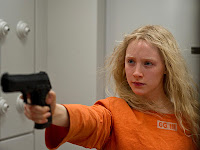Mission: Impossible:
Ghost Protocol had me at the opening credits. I’d forgotten that Brad Bird directed this film, and seeing
his name flash on the screen assured me that I was in for a good time.
You see, Brad Bird directed The Incredibles and Ratatouille. The
Incredibles is the greatest superhero movie ever made, and Ratatouille moved me to stand and
applaud when its credits rolled, something I’ve done exactly once. This guy knows what he’s doing and it
shows in this, his first live-action feature.
The Mission:
Impossible movies imagine what James Bond would be like if he weren’t a
sociopath. Tom Cruise, as secret
agent Ethan Hunt, can actually make and sustain friendships, lead people, and
present himself as more than a collection of top-shelf stuff he read about in
men’s lifestyle magazines. This
gives us an “in” to his character that the 007 movies simply can’t
deliver. This matters, because it
overcomes the fact that this spy thriller is just another entry in the “stop a
madman out to destroy the world / corner the market on X / extort ONE MILLION DOLLARS from the UN” genre. We like Ethan in a way that we simply
can’t like Bond. We like his team,
which includes recently omnipresent Doctor
Who alumnus Simon Pegg. We
like his boss. By God, we like the
Impossible Missions Force, whose self-destructing messaging systems sometimes
need a little whack to, y’know, actually self-destruct. So we’re on board when things get
rough.
And rough they get, giving Bird a reason to deliver breathtaking
action set-pieces. I’ve flown over
Dubai’s Burj Khalifa tower a zillion times, but it took this film to bring home
its awesome height. I’ve been in
sandstorms, but the sandstorm here felt more dangerous and more awesome than
any I’ve actually experienced. As
a film buff, I’ve seen more stunt fights in industrial settings than I can
remember; but I’ve never seen a stunt fight like the one this delivers in its
climax.
A friend of mine recently said that Brad Bird should get a
Bond film. I say that Mission: Impossible: Ghost Protocol is
as good as spy action-thrillers get, and better than any Bond film I can
readily recall. Brad Bird hasn’t
just raised the bar. He’s built a
better bar, taller and stronger and cooler and just plain more fun than the
bars that have gone before.
I can’t praise Mission:
Impossible: Ghost Protocol enough.
Brad Bird knows what he’s doing.
PS … except for
that last scene, which looked like it was filmed on different stock and tied everything
up far too neatly. Hey, people who
follow this kind of thing: was this a reshoot thing? I just don’t understand how you do two hours of excellence,
only to go mundane at the wrap.
Thoughts?





















